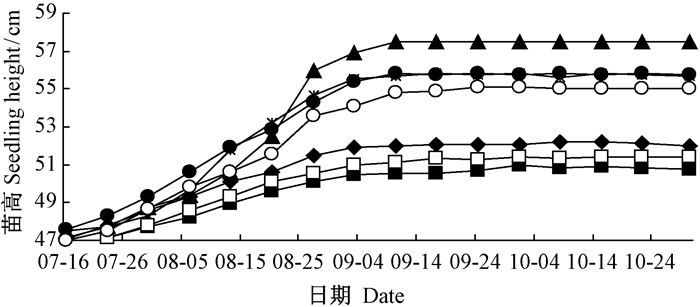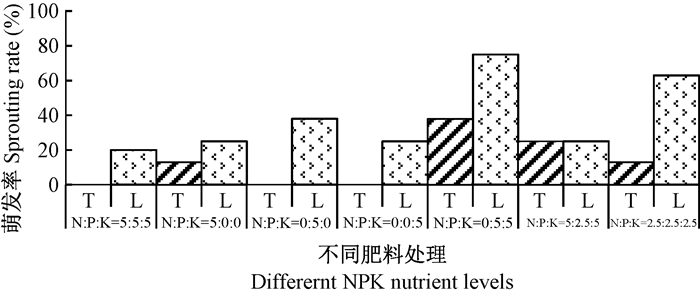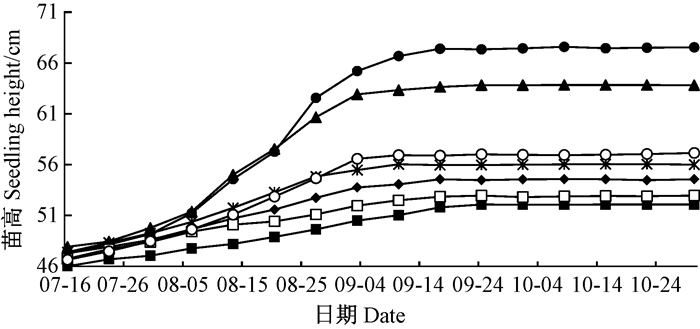文章信息
- 王艳梅, 张龙冲, 马天晓, 刘震, 任雪敏, 耿晓东, 宋良红
- Wang Yanmei, Zhang Longchong, Ma Tianxiao, Liu Zhen, Ren Xuemin, Geng Xiaodong, Song Lianghong
- 人工调控对泡桐顶芽生长发育的影响
- Effect of Artificial Regulation on Terminal Bud Growth of Paulownia spp.
- 林业科学, 2016, 52(8): 53-59
- Scientia Silvae Sinicae, 2016, 52(8): 53-59.
- DOI: 10.11707/j.1001-7488.20160807
-
文章历史
- 收稿日期:2015-10-22
- 修回日期:2016-04-01
-
作者相关文章
2. 黄河科技学院 郑州 450000;
3. 郑州市植物园 郑州 450042
2. Huanghe S & T College Zhengzhou 450000 ;
3. Zhengzhou Botanical Garden Zhengzhou 450042
泡桐(Paulownia spp.)生长快、材质好,是我国优良的速生用材树种之一。但泡桐顶芽易死亡,造成 “冠大干低”,严重影响桐材的产量与质量,也影响农桐间作时农作物的品质。竺肇华(1981)在四川资中地区调查了不同种类泡桐的越冬差异,侯元凯等(2001)研究了顶芽的耐寒性和水分变化,尝试土壤平埋保护顶芽越冬的方法(张存义等,1981; 侯元凯,2000),叶金山等(2009)分析了泡桐的假二叉分枝机制,针对泡桐顶芽死亡的原因有以下观点:低温所致、水分亏缺及“低温-水分胁迫假说”。刘震等(2004)在研究泡桐顶侧芽休眠发育的温度特性时提出了第4种观点,即泡桐顶芽死亡是泡桐在长期进化过程中获得的一种生理生态适应。多项试验拟通过温室栽培保存泡桐顶芽,但均未取得良好结果(蒋建平等,1980)。
树木生长发育是受多个因素和多种基因综合调控的复杂生命现象,其中光照、肥力、温度及水分等在树木生长发育中起着重要作用,调节植物生长、休眠或死亡。张书娜等(2015)研究了光照和施肥对白桦(Betula platyphylla)林冠下水曲柳(Fraxinus mandshurica)、胡桃楸(Juglans mandshurica)苗木生长的影响,认为水曲柳、胡桃楸苗木对光照强度和施肥响应明显; 尚旭岚等(2014)研究了光照和施肥对青钱柳(Cyclocarya paliurus)幼苗叶片性状与解剖结构的影响,认为中等光照且适量施肥是青钱柳幼苗生长的最佳条件。光周期可延长植物当年生长期 (张宋智等,2009)或在休眠封顶后重新绽开生长(张金凤等,2006)。光周期影响植物形态指标,补光处理可以明显促进植物生长(张宋智等,2009; 张金凤等,2006)。欧阳芳群等(2014)研究了补光对青海云杉(Picea crassifolia)家系幼苗生物量和矿质元素的影响,结果表明通过温室内延长光照时间,青海云杉1年生苗的苗高已超过传统露地育苗3年生苗,比常规育苗提早3~4年出圃。Burisch等(2015)研究了环境控制条件下光周期和温度对覆盆子(Rubus idaeus)生长与开花的影响,结果表明高生长和叶片形成的速率随温度的增加而增加,延长日照长度对叶片形成率无影响,但会增加节间长度。
目前光周期等环境因子的人工调控多集中在园艺、花卉及农作物等域领植物的花期调控,如草莓(Fragaria × ananassa)(Hamano et al., 2015)、美藤果(Plukenetia volubilis)(Yang et al., 2014)、菊花(Chrysanthemum morifolium)(Sumitomo et al., 2014)等,而对乔木类生长发育的人工调控报道相对较少。为此,本试验拟进行日照长度,日照长度和营养,日照长度、温度和水分等人工调控研究,探明日照长度、温度和水分等因子对泡桐顶芽生长发育的影响,这对探明泡桐顶芽死亡机制、丰富木本植物芽适应机制具有重要的理论意义。
1 试验地概况试验地位于河南农业大学林业试验站(113°38′E,34°47′N),属于暖温带大陆性气候, 四季分明,年平均气温14.2 ℃,极端最高温度43 ℃,极端最低温度-17.9 ℃,≥10 ℃积温4 717 ℃,无霜期215天,年平均降水量650.1 mm,全年日照时数约2 400 h。试验地土壤条件为砂壤土,偏中性,pH值7.0左右
2 材料与方法 2.1 日照长度对泡桐顶芽生长发育的影响以2010年4月播种培育的毛泡桐(P.tomentosa)容器实生苗(容器规格为30 cm×28 cm,下同)为试验材料。共设置8,12,14,16,24 h共5种日照长度处理,每处理3次重复,每重复15株。日照长度处理采用每日08:00—16:00接受自然光照。08:00前室内遮光,延长光照采用日光灯补充光照(500 lx)的方法,温度、水分不加控制。每天从16:00开始补光,补光时间长短依据试验设计而定。试验时间为2011年7月16日—10月30日。每隔7天观察1次泡桐的高生长状况。
2.2 日照长度及施肥对泡桐顶芽生长发育的影响在12,24 h日照长度下设置不同的施肥处理。试验采用单因素随机分组设计,设置6种处理和1种对照,每处理3次重复,每重复10株。供试验所用的肥料为:N肥选用尿素(含 N 46%),P肥选用过磷酸钙(含P2O5 12%),K肥选用硫酸钾(含K 49%)。每隔10天按照不同处理进行定量撒施并观测泡桐的高生长状况。N,P,K三因素配比如表 1。试验材料及起止时间同2.1。
|
|
日照长度、日照长度及施肥交互试验结束后,剪下苗木枝条置于25 ℃培养箱中水培,观察其顶侧芽的萌发情况,记录顶侧芽的萌发率。
2.3 24 h日照长度与温湿度对泡桐顶芽生长发育的影响以2012年5月培育的‘毛白33号’泡桐(P. tomentosa × P. fortunei 33)容器埋根苗为试验材料。秋季高生长停止前,移入玻璃温室,24 h连续光照处理。冬季采用电暖加热,保持温度在18 ℃以上。2012年8月24日—2013年5月17日置于温室调控环境中生长,2013年5月17日—2014年12月20日置于外界自然环境中生长。利用温湿度记录仪记录试验环境的温湿度,每小时1次。每间隔10天对高生长变化进行测量。
3 结果与分析 3.1 日照长度对泡桐顶芽生长发育的影响 3.1.1 日照长度对泡桐高生长的影响由图 1可知,不同日照长度处理的苗木高度随时间变化呈上升趋势之后逐渐趋于平缓,高度变化趋势比较一致,9月中旬至9月末达到各自的最大值。在不同日照长度处理之间,泡桐苗木高度增加量最大的是14 h,其次是16,24,12 h, 苗木高度增加量最小的是8 h,仅增加3.26 cm。对上述差异进行方差分析可知日照长度对泡桐苗木高度的影响差异极显著(P<0.01);多重比较结果可知,日照长度14 h的高度与8, 12, 24 h差异极显著(P<0.01); 日照16 h与8, 24 h差异极显著(P<0.01),与12 h差异显著(P<0.05); 而日照长度8 h与12, 24 h(P>0.05),12 h与24 h(P>0.05), 14 h与16 h之间的高度差异不显著(P>0.05)。高生长停止时间依次为日照长度8, 12 h和14, 16, 24 h停止最晚,为9月24日左右。

|
图 1 日照长度对泡桐苗木高生长的影响 Fig.1 Effects of photoperiod on the height in Paulownia spp. |
不同日照长度处理后的枝条在25 ℃下进行水培,其顶侧芽的萌发率如图 2所示,24 h处理后顶侧芽萌发率均最高,16 h顶芽次之,8 h与12 h顶芽未有萌发现象出现。

|
图 2 25 ℃下不同日照长度处理后泡桐顶侧芽的萌发率 Fig.2 The sprouting rate of terminal and lateral buds at the cutting branches in Paulownia spp.under conditions of continuous illumination at 25 ℃ T:顶芽Terminal buds; L:侧芽 Lateral buds.下同 The same below. |
由图 3可知,在不同配比肥料处理之间,单施P肥的苗木增加量最大,为10.03 cm;其次为PK肥(N∶P∶K=0∶5∶5)、单施K肥及处理6(N∶P∶K=2.5∶2.5∶2.5);变化量较小的为单施N肥(4.9 cm)、处理5(N∶P∶K=5∶2.5∶5)和CK。12 h日照长度下不同配比肥料各处理苗木高生长大多在9月3日结束,单施P肥与处理6(N∶P∶K=2.5∶2.5∶2.5)在9月10日高生长停止。

|
图 3 12 h日照长度下不同施肥配比对泡桐苗木高生长的影响
Fig.3 Effects of different NPK nutrient levels on the height in Paulownia spp.of 12h photoperiod
|
12 h日照长度下,不同配比肥料对泡桐苗木高生长影响差异极显著(P<0.01)。多重比较可知,CK与单施P肥、单施K肥、施PK肥(N∶P∶K=0∶5∶5)、处理6(N∶P∶K=2.5∶2.5∶2.5)差异极显著(P<0.01);处理5(N∶P∶K=5∶2.5∶5)与单施P肥、单施K肥、施PK肥(N∶P∶K=0∶5∶5)差异极显著(P<0.01),与处理6(N∶P∶K=2.5∶2.5∶2.5)差异显著(P<0.05); 单施N肥与单施P肥、单施K肥差异极显著(P<0.01),与处理5(N∶P∶K=5∶2.5∶5)处理差异显著(P<0.05);单施P肥与单施K、处理5(N∶P∶K=5∶2.5∶5)差异不显著(P>0.05)。
3.2.2 12 h日照长度下不同配比肥料处理后泡桐顶侧芽在25 ℃下的萌发率12 h日照长度下不同配比肥料处理后,泡桐苗木切枝水培顶侧芽萌发的情况如图 4所示。处理4的顶侧芽萌发率最高,CK、处理2和处理3顶芽未萌发。

|
图 4 12 h日照长度及施肥处理后泡桐顶侧芽在25 ℃下的萌发率 Fig.4 The sprouting rates of terminal and lateral buds on cutting in Paulownia spp. after being treated in different NPK nutrient on 12 h photoperiods at 25 ℃ |
由图 5可知,24 h日照长度下不同配比肥料对泡桐苗木高度的影响随时间变化呈逐渐上升趋势,不同处理变化趋势比较一致。其中单施K肥的苗木增加量最大,为20.32 cm;其次为单施P肥、处理6(N∶P∶K=2.5∶2.5∶2.5)、施PK肥(N∶P∶K=0∶5∶5); 变化量较小的为处理5(N∶P∶K=5∶2.5∶5)和CK。24 h日照长度下不同配比肥料各处理的高生长停止时间比较一致,在9月24日左右,这与24 h日照长度处理高生长停止时间差异不大。24 h日照长度下不同配比肥料对泡桐苗木高度的影响差异极显著(P<0.01)。多重比较可知,CK与处理5(N∶P∶K=5∶2.5∶5)、处理6(N∶P∶K=2.5∶2.5∶2.5)差异显著(P<0.05); 单施P肥与CK、单施N肥、施N P肥、处理5(N∶P∶K=5∶2.5∶5)、处理6(N∶P∶K=2.5∶2.5∶2.5)差异极显著(P<0.01); 单施K肥与CK、单施N肥、施PK肥、处理5(N∶P∶K=5∶2.5∶5)、处理6(N∶P∶K=2.5∶2.5∶2.5)差异极显著(P<0.01)。

|
图 5 24 h日照长度下不同施肥配比下泡桐苗木高度的变化 Fig.5 Effects of different NPK nutrient levels on the height in Paulownia spp. of 24 h photoperiod |
24 h日照长度下不同配比肥料处理后泡桐苗木切枝水培顶侧芽萌发的情况如图 6所示。CK顶芽萌发率最高,处理5侧芽萌发率最高,处理5 与处理1顶芽未萌发。

|
图 6 24 h日照长度及施肥处理后泡桐顶侧芽在25 ℃下的萌发率 Fig.6 The sprouting rates of terminal and lateral buds on cutting in Paulownia spp. after being treated in different NPK nutrient on 24 h photoperiods at 25 ℃ |
由图 7可知,2012年9月10日—2013年10月20日泡桐苗木高生长随时间变化呈上升趋势,其中2012年9月10日—2013年5月17日为人工调控环境。2012年11月9日—2013年12月20日,温度整体变化趋势为波形。2012年11月9日—2013年5月17日的温室环境中,温度基本维持在18 ℃以上,而泡桐高生长也在不断增加。2013年5月17日—2013年12月20日为自然环境。2013年10月10日后,温度开始降低且整体较低,此阶段高生长增速减缓直至生长停止。

|
图 7 2012—2013年‘毛白33’泡桐株高生长的变化规律及其对应的温湿度变化 Fig.7 The changes of the temperature and relative humidity of the atmosphereand thecorresponding growth of P. tomentosa×P. fortunei 33 inglassgreenhouse from 2012 to 2013 |
总体看来,温室的湿度较高且高于自然环境的湿度;自然状况下空气湿度受天气状况影响较大,因此空气湿度波动幅度比温室湿度变动大。
4 讨论 4.1 日照长度对泡桐生长的影响研究表明,补光处理可以明显促进植物生长(张宋智等,2009; 张金凤等,2006); 短日照处理会减弱植物生长(张桂茹,1997)。Immel等(1980)研究了日照长度对毛泡桐生长的影响,结果发现,16,24 h的毛泡桐苗木与8, 12 h相比生长量较大。本研究对泡桐顶芽的不同单一日照长度调控表明,泡桐对短日照反应并不灵敏,从2010年7月16日开始进行8 h短日照处理,直到2010年8月27日才停止生长,这表明短日照未能影响泡桐停止生长形成休眠芽;但日照长度影响存在且差异显著,体现在生长停止期与生长量2个方面。14 h日照长度条件下泡桐高生长最快,且高生长停止早; 泡桐在24 h全日照长度条件下生长期最长。但单一日照长度调控下泡桐顶芽最终仍会死亡,并不能实现泡桐的连续生长。
4.2 日照长度及施肥交互作用对泡桐生长的影响日照长度和肥力具有交互作用,且使植物对资源重新分配。已有研究表明,适度遮荫能改善植物的营养吸收,增大根生物量投入;全光照下地下生物量的投入减少。对青冈(Nothofagus glauca)盆栽苗的研究表明,青冈的生长显著受到光照与施肥的交互作用影响(Rómulo et al., 2013)。当肥力为变异来源时,营养对泡桐苗木的株高影响差异极显著; 当日照长度为变异来源时,12 h日照长度下单施P肥对泡桐苗木的高生长最有利;而在24 h日照长度下单施K肥最能促进泡桐苗木的高生长。12 h日照长度下N含量越大,对泡桐苗木高度抑制作用就越大。交互作用可延长泡桐生长期,但并不能避免顶芽死亡,实现连续生长或保存顶芽。
4.3 24 h日照长度及温湿度对泡桐生长发育的影响温度是与植物生长发育有重要关系的环境因子;但在自然环境中,影响植物越冬生存的环境因子不仅仅是气温,光也是一个可能成为胁迫的因素,其可能导致光氧化损伤(Arora et al., 2011)。Rohde等(2011)研究了低温与光周期对杨树(Populus spp.)生长停止的作用,结果表明光周期控制着杨树的生长停止与芽的形成,但温度的变化可能影响光周期调控的灵敏度; Ghelardini等(2010)研究了温度与光周期对榆树(Ulmus spp.)生长及休眠的影响,发现长日照对榆树休眠的解除没有效果,温度才是主要的。Johansson等(2014)研究发现温度对欧美山杨(Populus tremula× P. tremuloides)芽的形成、萌发温度存在差异。低温对植物生长影响较大(乌凤章等,2015)。刘震等(2004)研究表明泡桐顶芽不是因为早霜或低温冻害而死;也有研究提出低温不是泡桐顶芽冬季死亡的唯一原因(竺肇华,1981; 张存义等,1981; 侯元凯等,2002; 黎明等,2007)。郑州9月的最低温度一般在15 ℃左右,这样的温度一般不应引起顶芽死亡,但郑州的泡桐一般在9月下旬基本停止生长。这表明在自然状态下,泡桐忍耐低温或者感应低温的阈值要高于一般意义上的低温,这也可能是在18 ℃以上可能连续生长的原因之一。
侯元凯等(2000; 2001)认为泡桐顶芽死亡是由于水分亏缺导致的。黎明等(2007)对1年生毛泡桐盆栽实生苗顶芽进行了解剖学观察,结果发现毛泡桐顶芽顶端分生组织细胞很可能受到了水分胁迫,顶芽死亡可能是水分胁迫所致。叶金山等(2009)的温室盆栽试验(顶梢套瓶+注水)表明顶芽可不死亡,也证实了水分在泡桐顶芽安全越冬中的重要性,并提出了“低温-水分胁迫假设”,认为冬季的低温胁迫和水分胁迫单独或共同的作用导致泡桐顶芽死亡。本研究空气相对湿度较高,排除了水分的限制因素。
5 结论延长日照长度可促进苗木生长,延长当年生长期,但单一日照长度不能诱导形成休眠芽或实现连续生长。日照长度及施肥具有交互作用,在保证充分营养的基础上,24 h日照长度也无法诱导泡桐顶芽的连续生长,且对泡桐生长停止的影响与日照长度处理基本一致。控制温度18 ℃以上、在24 h日照长度下能够实现泡桐的连续生长。
| [] |
侯元凯, 翟明普, 聂爱社, 等. 2001. 兰考泡桐苗木顶芽水分变化规律研究. 北京林业大学学报 , 23 (6) : 17–21.
( Hou Y K, Zhai M P, Nie A S, et al.2001. Law of water change of top buds of Paulownia elongata seedlings. Journal of Beijing Forestry University , 23 (6) : 17–21. [in Chinese] ) (  0) 0)
|
| [] |
侯元凯, 翟明普, 聂爱社, 等. 2002. 兰考泡桐苗木顶芽耐寒性研究. 中国生态农业学报 , 10 (2) : 19–21.
( Hou Y K, Zhai M P, Nie A S, et al.2002. Study on cold resistance of top buds of Paulownia elongata seedlings. Chinese Journal of Eco-Agriculture , 10 (2) : 19–21. [in Chinese] ) (  0) 0)
|
| [] |
侯元凯, 翟明普, 张俊昌, 等. 2000. 兰考泡桐苗木顶芽越冬特性初步研究. 河南农业大学学报 , 34 (2) : 196–197,200.
( Hou Y K, Zhai M P, Zhang J C, et al.2000. Study on overwinter specific property of top buds of Paulownia elongata. Journal of Henan Agricultural University , 34 (2) : 196–197,200. [in Chinese] ) (  0) 0)
|
| [] |
蒋建平, 李荣幸, 刘廷志, 等. 1980. 予选一号和予杂一号泡桐的选育与推广. 河南农学院学报 , 14 (3) : 1–9.
( Jiang J P, Li R X, Liu D Z, et al.1980. Breeding and extension of Paulownia ‘Yuxuan No.1’ and Paulownia ‘Yuza No.1’. Journal of Henan Agricultural University , 14 (3) : 1–9. [in Chinese] ) (  0) 0)
|
| [] |
黎明, 祝宝玉, 范国强, 等. 2007. 秋冬季节温度变化对毛泡桐实生幼苗顶芽生长发育的影响. 河南农业大学学报 , 41 (3) : 280–283.
( Li M, Zhu B Y, Fan G Q, et al.2007. Effect of temperature change from fall to winter on growth and development of the top buds of Plauownia tomentosa seedlings. Journal of Henan Agricultural University , 41 (3) : 280–283. [in Chinese] ) (  0) 0)
|
| [] |
刘震, 何松林, 王艳梅, 等. 2004. 泡桐顶侧芽休眠发育的温度特性研究. 林业科学 , 40 (3) : 46–50.
( Liu Z, He S L, Wang Y M, et al.2004. Study on the temperature characteristics of dormancy development of terminal and lateral buds in Paulownia. Scientia Silvae Sinicae , 40 (3) : 46–50. [in Chinese] ) (  0) 0)
|
| [] |
欧阳芳群, 王军辉, 贾子瑞, 等. 2014. 补光对青海云杉家系幼苗生物量和矿质元素的影响. 林业科学 , 50 (11) : 188–196.
( Ouyang F Q, Wang J H, Jia Z R, et al.2014. Effects of supplemental light on biomass and mineral element content of seedlings from nine families in Picea crassifolia. Scientia Silvae Sinicae , 50 (11) : 188–196. [in Chinese] ) (  0) 0)
|
| [] |
尚旭岚, 李琼琼, 邓波, 等. 2014. 光照和施肥对青钱柳幼苗叶片性状与解剖结构的影响. 西南林业大学学报 , 34 (6) : 9–15.
( Shang X L, Li Q Q, Deng B, et al.2014. Effects of light intensity and fertilization on leaf traits and anatomical structure of Cyclocarya paliurus. Jounal of Southwest Forestry Univesity , 34 (6) : 9–15. [in Chinese] ) (  0) 0)
|
| [] |
乌凤章, 王贺新, 徐国辉, 等. 2015. 木本植物低温胁迫生理及分子机制研究进展. 林业科学 , 51 (7) : 116–128.
( Wu F Z, Wang H X, Xu G H, et al.2015. Research progress on the physiological and molecular mechanisms of woody plants under low temperature stress. Scientia Silvae Sinicae , 51 (7) : 116–128. [in Chinese] ) (  0) 0)
|
| [] |
叶金山, 杨文萍. 2009. 泡桐假二叉分枝机理. 东北林业大学学报 , 37 (2) : 6–7.
( Ye J S, Yang W P.2009. Mechanism of false dichotomous branching for Paulownia. Journal of Northeast Forestry University , 37 (2) : 6–7. [in Chinese] ) (  0) 0)
|
| [] |
张存义, 殷年喜. 1981. 泡桐新的接干方法——顶芽接干. 安阳林业科技 (1) : 2–53.
( Zhang C Y, Yin N X.1981. The new method of trunk extension in Paulownia-using terminal bud. Anyang Forestry Science and Technology (1) : 2–53. [in Chinese] ) (  0) 0)
|
| [] |
张桂茹. 1997. 光周期对大豆品种生育进程及农艺性状的影响. 中国油料 , 14 (2) : 37–39.
( Zhang G R.1997. Photoperiodic effects on growth and development periods and agronomic characteristics in soybean. Oil Crops of China , 14 (2) : 37–39. [in Chinese] ) (  0) 0)
|
| [] |
张金凤, 张华丽, 王军辉, 等. 2006. 延长光周期对科罗拉多冷杉容器苗生长的效应. 北京林业大学学报 , 28 (1) : 107–110.
( Zhang J F, Zhang H L, Wang J H, et al.2006. Effects of extended photoperiod on the growth of Abies concolor seedlings. Journal of Beijing Forestry Uiversity , 28 (1) : 107–110. [in Chinese] ) (  0) 0)
|
| [] |
张书娜, 王庆成, 郝龙飞, 等. 2015. 光照和施肥对白桦林冠下水曲柳、胡桃楸苗木生长的影响. 森林工程 , 31 (2) : 51–56.
( Zhang S N, Wang Q C, Hao L F, et al.2015. Effects of light and fertilization on the growth of Fraxinus mandshurica and Juglans mandshurica seedlings under the canopy of Betula platyphylla secondary forest. Foest Engineeing , 31 (2) : 51–56. [in Chinese] ) (  0) 0)
|
| [] |
张宋智, 王军辉, 孙蒋明, 等. 2009. 欧洲云杉不同种源补光育苗试验. 西北林学院学报 , 24 (3) : 75–79.
( Zhang S Z, Wang J H, Sun J M, et al.2009. Seedling culture of Picea abies by supplement light. Journal of Northwest Forestry University , 24 (3) : 75–79. [in Chinese] ) (  0) 0)
|
| [] |
竺肇华. 1981. 泡桐属植物的分布中心及区系成分的探讨. 林业科学 , 17 (3) : 271–280.
( Zhu Z H.1981. Adiscusion on the distribution centre and flora of Paulownia genus. Scientia Silvae Sinicae , 17 (3) : 271–280. [in Chinese] ) (  0) 0)
|
| [] |
Arora R, Rowland L J.2011. Physiological research onwinter-hardiness:deacclimationresistance,reacclimationability,photoprotection strategies,and a cold acclimation protocol design. HortScience , 46 (8) : 1070–1078.
( 0) 0)
|
| [] |
Burisch M, Rhenius D.2015. Effects of photoperiod and temperature on growth and flowering in the annual (primocane) fruiting raspberry (Rubus idaeus L.) cultivar ‘Polka’. .The Journal of Horticultural Science and Biotechnology , 84 (4) : 439–446.
( 0) 0)
|
| [] |
Ghelardini L, Santini A, Black-Samuelsson S, et al.2010. Bud dormancy release in elm (Ulmus spp.) clones-a case study of photoperiod and temperature responses. Tree Physiology , 30 : 264–274.
DOI:10.1093/treephys/tpp110 ( 0) 0)
|
| [] |
Hamano M, Kato K, Honda K, et al.2015. Promotion of flowering by photoperiod treatment in six strawberry (Fragaria×ananassa Duch.) cultivars with different everbearing patterns. The Journal of Horticultural Science and Biotechnology , 90 (2) : 157–163.
DOI:10.1080/14620316.2015.11513167 ( 0) 0)
|
| [] | Immel M J,Tackett E M,Carpenter S B.1980. Paulownia seedling respond to increased daylight.Tree Planters Notes,3-5. |
| [] |
Johansson M, Takata N, Ibáñez C, et al.2014. Monitoring seasonal bud set,bud burst,and cold hardiness in Populus. Plant Circadian Networks,Springer New York : 313–324.
( 0) 0)
|
| [] |
Rohde A, Bastien C, Boerjan W.2011. Temperature signals contribute to the timing of photoperiodic growth cessation and bud set in poplar. Tree Physiology , 31 (5) : 472–482.
DOI:10.1093/treephys/tpr038 ( 0) 0)
|
| [] |
Rómulo S, Sergio E, Antonio C A, et al.2013. Effect of shading and fertilisation on the development of container-grown Nothofagus glauca seedlings,a threatened species from central Chile. Southern Forests A Journal of Forest Science , 75 (3) : 145–148.
DOI:10.2989/20702620.2013.816234 ( 0) 0)
|
| [] |
Sumitomo K, Yamagata A, Oda A, et al.2014. Identification of high long-day leaf number cultivars and prevention of premature budding by cold pre-treatment for fine control of flowering in summer-to-autumn-flowering chrysanthemum (Chrysanthemum morifolium Ramat). The Journal of Horticultural Science and Biotechnology , 89 (6) : 647–654.
DOI:10.1080/14620316.2014.11513133 ( 0) 0)
|
| [] |
Yang C, Jiao D Y, Geng Y J, et al.2014. Planting density and fertilisation independently affect seed and oil yields in Plukenetia volubilis L.plants. The Journal of Horticultural Science and Biotechnology , 89 (2) : 201–207.
DOI:10.1080/14620316.2014.11513069 ( 0) 0)
|
 2016, Vol. 52
2016, Vol. 52

